材料物资核算表
- 格式:doc
- 大小:249.00 KB
- 文档页数:15
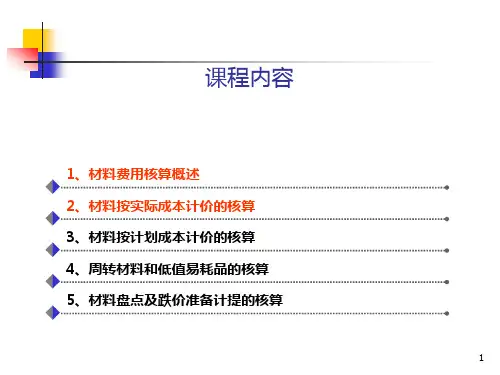
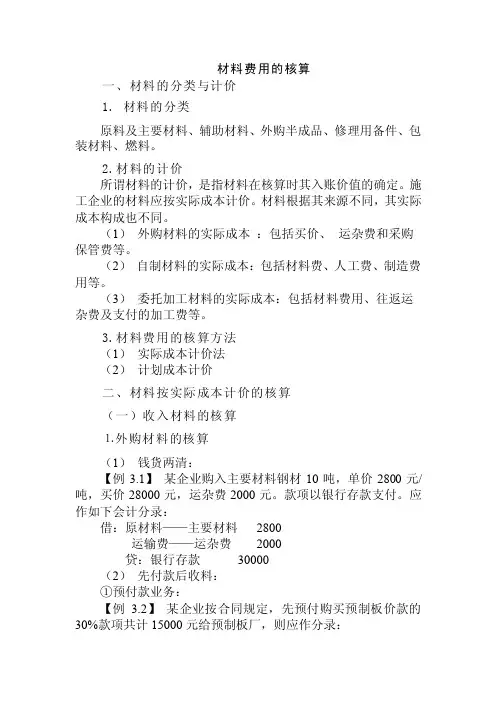
材料费用的核算一、材料的分类与计价1. 材料的分类原料及主要材料、辅助材料、外购半成品、修理用备件、包装材料、燃料。
2.材料的计价所谓材料的计价,是指材料在核算时其入账价值的确定。
施工企业的材料应按实际成本计价。
材料根据其来源不同,其实际成本构成也不同。
(1)外购材料的实际成本:包括买价、运杂费和采购保管费等。
(2)自制材料的实际成本:包括材料费、人工费、制造费用等。
(3)委托加工材料的实际成本:包括材料费用、往返运杂费及支付的加工费等。
3.材料费用的核算方法(1)实际成本计价法(2)计划成本计价二、材料按实际成本计价的核算(一)收入材料的核算⒈外购材料的核算(1)钱货两清:【例3.1】某企业购入主要材料钢材10吨,单价2800元/吨,买价28000元,运杂费2000元。
款项以银行存款支付。
应作如下会计分录:借:原材料——主要材料2800运输费——运杂费2000贷:银行存款30000(2)先付款后收料:①预付款业务:【例3.2】某企业按合同规定,先预付购买预制板价款的30%款项共计15000元给预制板厂,则应作分录:借:预付账款——某预制板厂15000贷:银行存款15000对方发票到达,价款为50000元,另我方应负担对方垫付的运杂费3000元,款项均以存款支付,同时材料验收入库,。
则应作会计分录:借:原材料——结构件53000贷:预付账款——某预制板厂15000银行存款38000②正常结算引起的先付款后收料业务【例3.3】某企业购入水泥10吨,每吨200元,另支付运杂费500元,对方发票已到,企业开出现金支票付款。
材料尚未到达。
则付款时应作如下会计分录:借:在途物资——某单位(水泥)2500贷:银行存款2500以后材料到达验收入库则作会计分录:借:原材料——主要材料2500贷:在途物资2500(3)先收料后付款①赊购业务:【例3.4】某企业赊购黄沙10车,每车200元,共计2000元。
黄沙已入场验收,对方发票已到,但单位未支付货款。
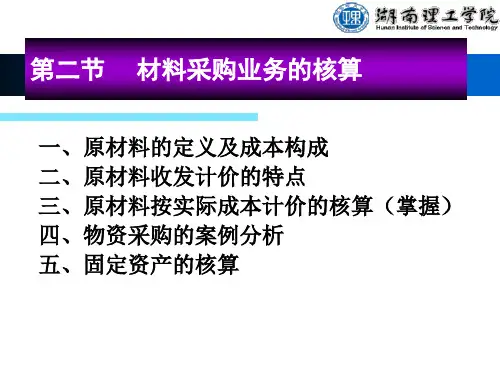
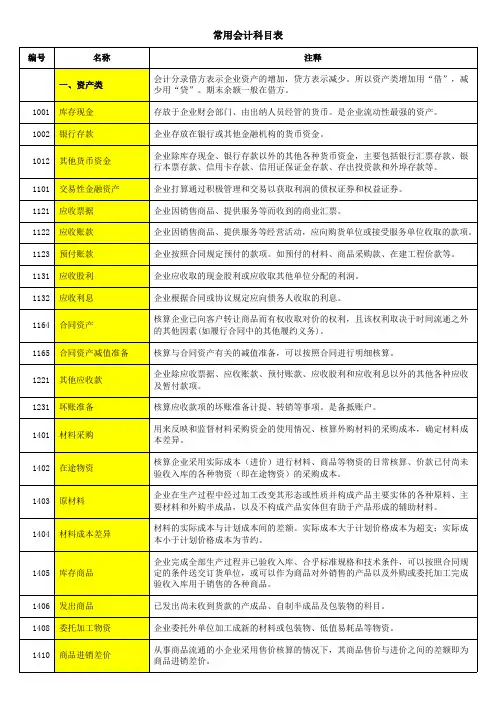
常用会计科目表1411周转材料企业能够多次使用,不符合固定资产定义,逐渐转移其价值但仍保持原有形态的材料物品。
1471存货跌价准备在资产负债表日,存货的可变现净值低于成本,企业应当计提存货跌价准备。
1501债权投资债券购买人以购买债券的形式投放资本,到期向债券发行人收取固定的利息以及收回本金的一种投资方式。
1502其他债权投资核算企业按照本准则第十八条分类为以公允价值计量且其变动计入其他综合收益的金融资产。
1503其他权益工具投资核算企业指定为以公允价值计量且其变动计入其他综合收益的非交易性权益工具投资。
1511长期股权投资投资企业对被投资单位实施控制、重大影响的权益性投资、以及对其合营企业的权益性投资。
1512长期股权投资减值准备针对长期股权投资账面价值而言的,在期末时按账面价值与可收回金额孰低的原则来计量,对可收回金额低于账面价值的差额计提长期股权投资减值准备。
1521投资性房地产为赚取租金或资本增值,或两者兼有而持有的房地产。
1531长期应收款企业融资租赁产生的应收款项和采用递延方式分期收款、实质上具有融资性质的销售商品和提供劳务等经营活动产生的应收款项。
1601固定资产为生产商品、提供劳务、出租或经营管理而持有;使用寿命超过一个会计年度的资产。
1602累计折旧企业在报告期末提取的各年固定资产折旧累计数。
1603固定资产减值准备固定资产发生损坏、技术陈旧或者其他经济原因,导致其可收回金额低于其账面价值。
1604在建工程企业固定资产的新建、改建、扩建,或技术改造、设备更新和大修理工程等尚未完工的工程支出。
1605工程物资用于固定资产建造的建筑材料(如钢材、水泥、玻璃等),企业(民用航空运输)的高价周转件(例如飞机的引擎)等。
1606固定资产清理固定资产的报废和出售,以及因各种不可抗力的自然灾害而遭到损坏和损失的固定资产所进行的清理工作。
1701无形资产企业拥有或者控制的没有实物形态的可辨认的非货币性资产。
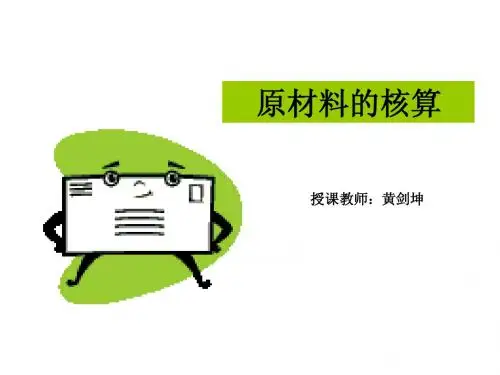
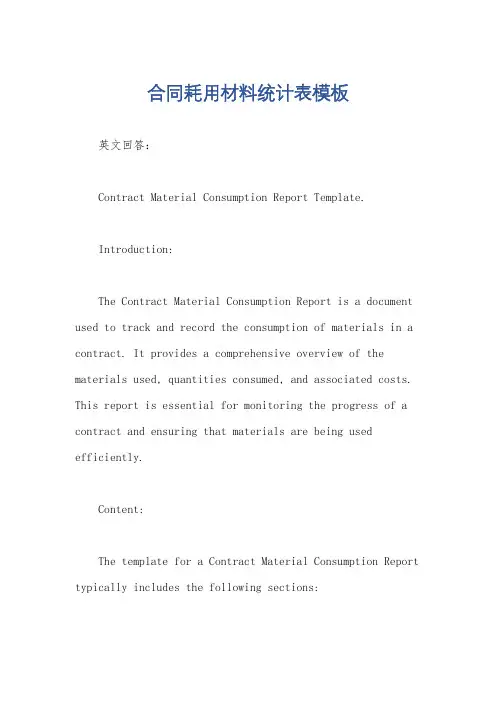
合同耗用材料统计表模板英文回答:Contract Material Consumption Report Template.Introduction:The Contract Material Consumption Report is a document used to track and record the consumption of materials in a contract. It provides a comprehensive overview of the materials used, quantities consumed, and associated costs. This report is essential for monitoring the progress of a contract and ensuring that materials are being used efficiently.Content:The template for a Contract Material Consumption Report typically includes the following sections:1. Contract Details: This section includes information about the contract, such as the contract number, project name, and contract period. It provides a brief overview of the contract's scope and objectives.2. Material Details: This section lists all the materials that are being used in the contract. It includes the material name, code, unit of measurement, and cost per unit. Additionally, it may include information about the supplier or vendor from whom the materials are being procured.3. Consumption Details: This section records the quantity of materials consumed during a specific period. It includes the date of consumption, quantity consumed, and the corresponding cost. This information helps in tracking the material usage and identifying any discrepancies or inefficiencies.4. Cost Analysis: This section provides a summary of the total cost incurred for each material. It includes the total quantity consumed, unit cost, and the total cost.This analysis helps in evaluating the overall expenditureon materials and identifying opportunities for cost savings.5. Remarks: This section allows for any additional comments or observations related to the material consumption. It can be used to highlight any issues or challenges faced during the contract period or suggest improvements for future contracts.Example:To illustrate the usage of the Contract Material Consumption Report, let's consider a construction project. The contract involves building a commercial complex, and various materials such as cement, steel, bricks, and electrical fittings are required.In the Material Details section, the report will list these materials along with their respective codes, units of measurement (e.g., bags, tons, pieces, etc.), and costs per unit. For instance, cement may be listed as Material Code: CMT001, Unit: Bags, and Cost per Bag: $10.In the Consumption Details section, the report will record the quantity of each material consumed during a specific period. For example, if 100 bags of cement were used on a particular day, the report will include the date, quantity consumed (100 bags), and the corresponding cost ($1000).The Cost Analysis section will summarize the total cost incurred for each material. It will calculate the total quantity consumed (e.g., 500 bags of cement), multiply itby the unit cost ($10 per bag), and provide the total cost ($5000). This analysis will help in evaluating the overall expenditure on materials and identifying any cost variances.The Remarks section can be used to note any issues or observations related to material consumption. For instance, if there were delays in material delivery or if there were instances of material wastage, it can be mentioned here.中文回答:合同耗用材料统计表模板。
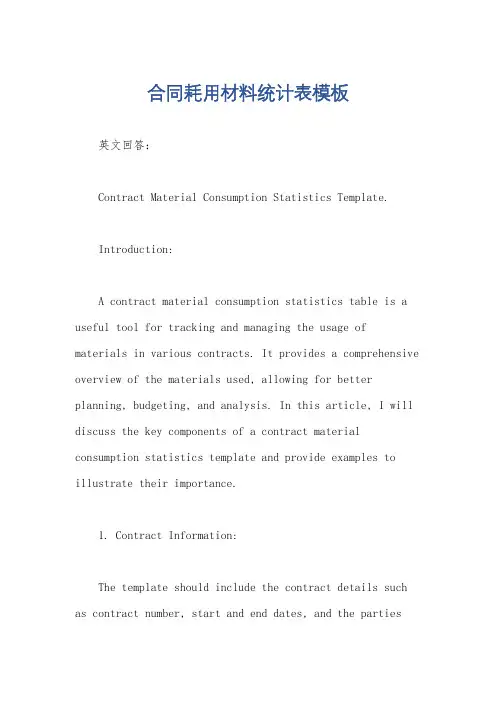
合同耗用材料统计表模板英文回答:Contract Material Consumption Statistics Template.Introduction:A contract material consumption statistics table is a useful tool for tracking and managing the usage of materials in various contracts. It provides a comprehensive overview of the materials used, allowing for better planning, budgeting, and analysis. In this article, I will discuss the key components of a contract material consumption statistics template and provide examples to illustrate their importance.1. Contract Information:The template should include the contract details such as contract number, start and end dates, and the partiesinvolved. This information helps in identifying which contract the materials are associated with and provides a reference for future analysis.Example: Let's say I am working on a construction project and have multiple contracts with different suppliers. The template will have separate sections for each contract, clearly indicating the contract number,start and end dates, and the names of the suppliers.2. Material Details:The template should have a section to record thedetails of the materials used, including the material name, quantity, unit of measurement, and cost. This information helps in understanding the consumption patterns and cost implications of different materials.Example: If I am managing a manufacturing contract, the template will have columns to enter the names of the materials used, such as steel, plastic, or rubber. I can then record the quantity of each material used in thecorresponding column and calculate the total cost based on the unit cost provided.3. Consumption Analysis:The template should include a section for analyzing the material consumption. This can be done by calculating the total quantity and cost of materials used for each contract, as well as the average consumption per unit or time period.Example: Let's say I have a contract for supplyingoffice stationery. The template will calculate the total quantity and cost of materials used, such as pens, papers, and staplers. It will also provide the average consumption per employee per month, allowing me to identify any excessive or insufficient usage.4. Variance Analysis:The template should include a section for variance analysis, comparing the actual material consumption withthe planned or budgeted consumption. This helps inidentifying any deviations and taking appropriate actions to control costs or improve efficiency.Example: If I have a contract for providing IT equipment, the template will compare the actual quantity and cost of materials used with the planned quantities and costs. If there is a significant variance, it may indicate issues such as overstocking or underutilization of resources, prompting me to investigate and make necessary adjustments.中文回答:合同耗用材料统计表模板。
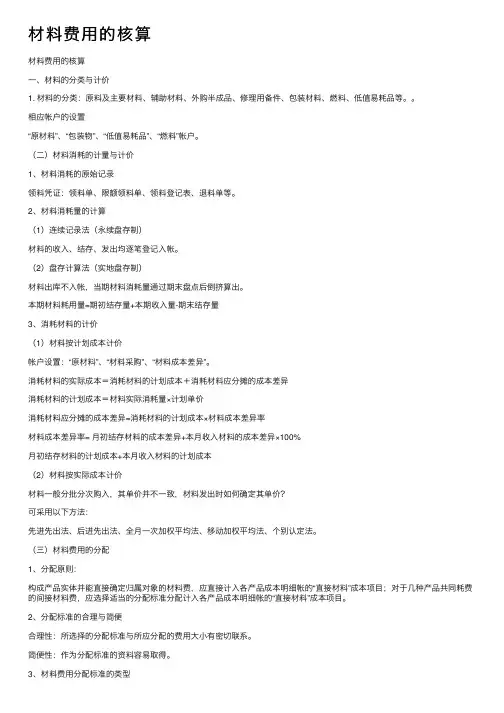
材料费⽤的核算材料费⽤的核算⼀、材料的分类与计价1. 材料的分类:原料及主要材料、辅助材料、外购半成品、修理⽤备件、包装材料、燃料、低值易耗品等。
相应帐户的设置“原材料”、“包装物”、“低值易耗品”、“燃料”帐户。
(⼆)材料消耗的计量与计价1、材料消耗的原始记录领料凭证:领料单、限额领料单、领料登记表、退料单等。
2、材料消耗量的计算(1)连续记录法(永续盘存制)材料的收⼊、结存、发出均逐笔登记⼊帐。
(2)盘存计算法(实地盘存制)材料出库不⼊帐,当期材料消耗量通过期末盘点后倒挤算出。
本期材料耗⽤量=期初结存量+本期收⼊量-期末结存量3、消耗材料的计价(1)材料按计划成本计价帐户设置:“原材料”、“材料采购”、“材料成本差异”。
消耗材料的实际成本=消耗材料的计划成本+消耗材料应分摊的成本差异消耗材料的计划成本=材料实际消耗量×计划单价消耗材料应分摊的成本差异=消耗材料的计划成本×材料成本差异率材料成本差异率= ⽉初结存材料的成本差异+本⽉收⼊材料的成本差异×100%⽉初结存材料的计划成本+本⽉收⼊材料的计划成本(2)材料按实际成本计价材料⼀般分批分次购⼊,其单价并不⼀致,材料发出时如何确定其单价?可采⽤以下⽅法:先进先出法、后进先出法、全⽉⼀次加权平均法、移动加权平均法、个别认定法。
(三)材料费⽤的分配1、分配原则:构成产品实体并能直接确定归属对象的材料费,应直接计⼊各产品成本明细帐的“直接材料”成本项⽬;对于⼏种产品共同耗费的间接材料费,应选择适当的分配标准分配计⼊各产品成本明细帐的“直接材料”成本项⽬。
2、分配标准的合理与简便合理性:所选择的分配标准与所应分配的费⽤⼤⼩有密切联系。
简便性:作为分配标准的资料容易取得。
3、材料费⽤分配标准的类型定额消耗量⽐例、系数⽐例、产品产量⽐例、重量⽐例、体积⽐例等。
4、定额消耗量⽐例分配法计算公式如下:某种产品材料定额消耗量=该种产品实际产量×单位产品材料消耗定额材料消耗量分配率=材料实际总消耗量÷各产品材料定额消耗量之和某种产品应分配的材料数量=该种产品的材料定额消耗量×材料消耗量分配率某种产品应分配的材料费⽤= 该种产品应分配的材料数量×材料单价以上⽅法可考核材料消耗定额的执⾏情况,有利于加强成本管理。
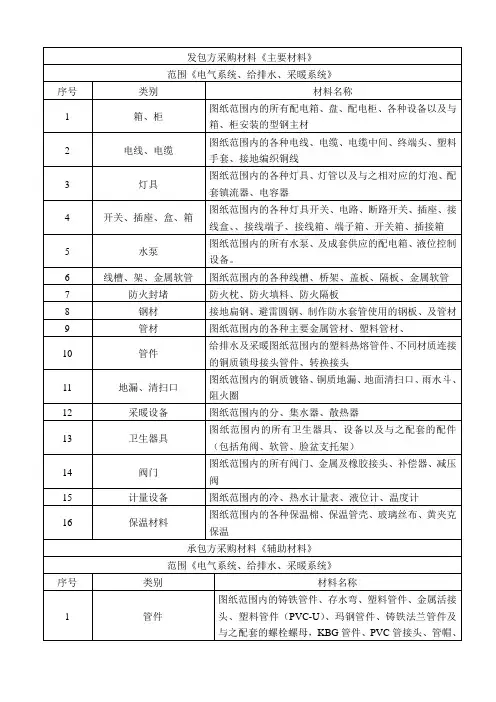
注:未尽事宜按北京市建设工程预算定额(2001)执行,上述表格内及定额未包括事项双方协商解决。
辅材承包方未采购,发包方采购的,结算时扣除此项。
发包方负责人签字:承包方负责人签字:年月日年月日企业所得税年度纳税申报表附表一(1)收入明细表经办人(签章): 法定代表人(签章):附表一(1)《收入明细表》填报说明一、适用范围本表适用于执行企业会计制度、小企业会计制度、企业会计准则以及分行业会计制度的一般工商企业的居民纳税人填报。
二、填报依据和内容根据《中华人民共和国企业所得税法》及其实施条例、相关税收政策,以及企业会计制度、小企业会计制度、企业会计准则,以及分行业会计制度规定,填报“主营业务收入”、“其他业务收入”和“营业外收入”,以及根据税收规定确认的“视同销售收入”。
三、有关项目填报说明1.第1行“销售(营业)收入合计”:填报纳税人根据国家统一会计制度确认的主营业务收入、其他业务收入,以及根据税收规定确认的视同销售收入。
本行数据作为计算业务招待费、广告费和业务宣传费支出扣除限额的计算基数。
2.第2行“营业收入合计”:填报纳税人根据国家统一会计制度确认的主营业务收入和其它业务收入。
本行数额填入主表第1行。
3.第3行“主营业务收入”:根据不同行业的业务性质分别填报纳税人按照国家统一会计制度核算的主营业务收入。
(1)第4行“销售货物”:填报从事工业制造、商品流通、农业生产以及其他商品销售企业取得的主营业务收入。
(2)第5行“提供劳务”:填报从事提供旅游饮食服务、交通运输、邮政通信、对外经济合作等劳务、开展其他服务的纳税人取得的主营业务收入。
(3)第6行“让渡资产使用权”:填报让渡无形资产使用权(如商标权、专利权、专有技术使用权、版权、专营权等)而取得的使用费收入以及以租赁业务为基本业务的出租固定资产、无形资产、投资性房地产在主营业务收入中核算取得的租金收入。
(4)第7行“建造合同”:填报纳税人建造房屋、道路、桥梁、水坝等建筑物,以及船舶、飞机、大型机械设备等取得的主营业务收入。
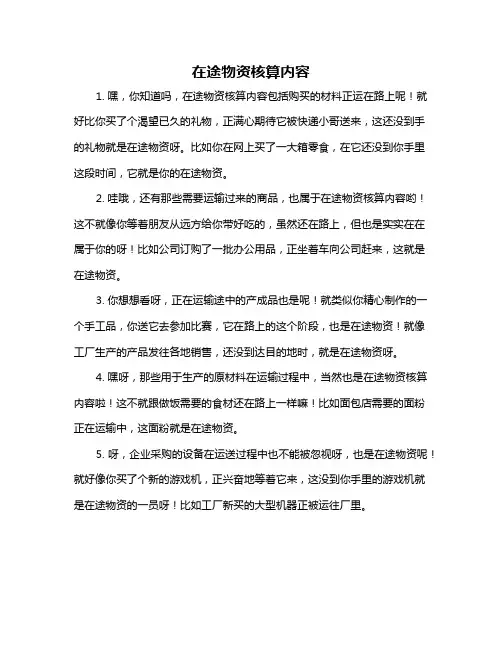
在途物资核算内容1. 嘿,你知道吗,在途物资核算内容包括购买的材料正运在路上呢!就好比你买了个渴望已久的礼物,正满心期待它被快递小哥送来,这还没到手的礼物就是在途物资呀。
比如你在网上买了一大箱零食,在它还没到你手里这段时间,它就是你的在途物资。
2. 哇哦,还有那些需要运输过来的商品,也属于在途物资核算内容哟!这不就像你等着朋友从远方给你带好吃的,虽然还在路上,但也是实实在在属于你的呀!比如公司订购了一批办公用品,正坐着车向公司赶来,这就是在途物资。
3. 你想想看呀,正在运输途中的产成品也是呢!就类似你精心制作的一个手工品,你送它去参加比赛,它在路上的这个阶段,也是在途物资!就像工厂生产的产品发往各地销售,还没到达目的地时,就是在途物资呀。
4. 嘿呀,那些用于生产的原材料在运输过程中,当然也是在途物资核算内容啦!这不就跟做饭需要的食材还在路上一样嘛!比如面包店需要的面粉正在运输中,这面粉就是在途物资。
5. 呀,企业采购的设备在运送过程中也不能被忽视呀,也是在途物资呢!就好像你买了个新的游戏机,正兴奋地等着它来,这没到你手里的游戏机就是在途物资的一员呀!比如工厂新买的大型机器正被运往厂里。
6. 你知道不,委托外单位加工的物资,在运输回自己这儿的时候,也是在途物资哦!这就像把宝贝寄出去加工,等它回来的路上就是在途物资呀!像把一些零件委托给其他工厂加工,它们在回来路上就是在途物资。
7. 哎呀,那些发出用于销售的货物,在运输期间,同样是在途物资呀!就类似你给别人寄的礼物,它在路上就是属于在途物资!比如电商平台上卖出的商品正在发给顾客的途中。
8. 可不是嘛,运往仓库的物品在途中也是在途物资哦!这就相当于要回家的宝贝还在路上呢!就像超市采购的商品正往仓库运送,这时候这些商品就是在途物资。
总之,在途物资就是那些还在路上的各种物资呀,不管是材料、商品还是设备,只要没到最终目的地,都可以算是在途物资呢!。

主要材料需用量核算表
年月日—
备注:①房建施工中具体到每个栋号分部分项。
②数量中应包含各种材料的损耗数量在内,此表中数量作为限额发放数量的主要依据。
附表1:
主要物资总量计划
%
项目经理:总工:工程部长:物资部长:编制人:
附表2:
材料资金申请计划
项目部:年月
项目名称:单位:万元
分管副总:物资部长:编制人:
附件3
分工号物资限(定)额发料台帐
!
项目名称:工号:
备注:限额数量的调整应由工程部提供书面材料。
<
附表7 :
施工队伍限额领料单
领料单位:计划量:调整用量:
备注:计划量及调整用量应由工程部提供书面材料。
·
附表8 :
附表5:
有权领料人授权书
授权单位:
被授权人:姓名,性别,年龄,民族,工作单位和职务:(身份证复印件附后)。
授权内容:授权单位委托为委托代理人,授权其代表本单位向鋳信集团建筑公司凤阳项目经理部领取材料,办理材料名称、规格、数量、质量、价款的签认及结算、扣付款等事宜,并负责处理与之相关的一切事务。
由被授权人签字或盖章的收料单、结算单等资料,授权单位均予以认可其法律效力。
授权单位(盖章):
地址:
被授权人(签字):
日期:年月日
注:本授权书适用于项目经理部对外发料。
附表6:
施工队伍授权领料人台帐项目部:
附表9:
物资盘点表
盘点日期:盘点人:
注明:本月库存量=盘点原材料+盘点半成品-已完工未收方+未完工已收方
附表10:
月材料消耗核算表
注:应耗数量由项目工程部在月收方后3个工作日内提供;
实耗数量=上期库存+本期进料-本期库存
附表11 :
施工队伍材料消耗月度结算单
施工队名称:
项目经理:财务部长:物资部长:施工队:核算日期注:1.节奖超罚金额各项目部自行确定;2. 工程材料核算单为劳务队伍结算计价扣除材料款的依据,无材料核算的,不予结算计价。
主要材料消耗考核表
工程名称:年月日
项目经理:总工:财务部长:物资部长:制表人:
附表13
材料动态报表
填报单位:(章)年月
项目经理:物资部长:审核:编制人:
附表12
"。